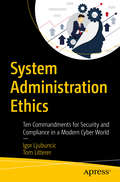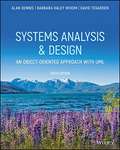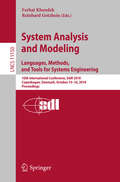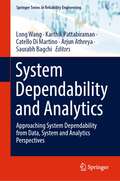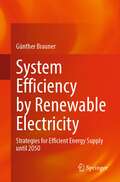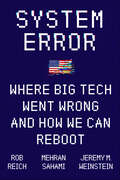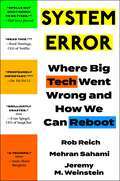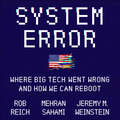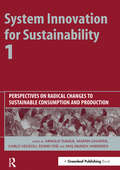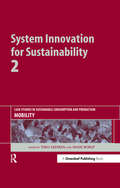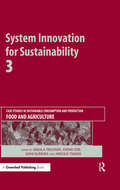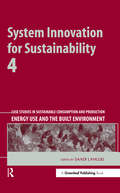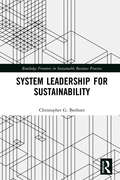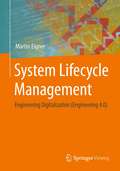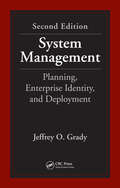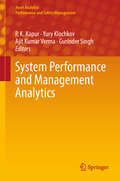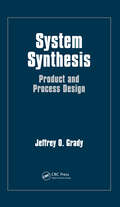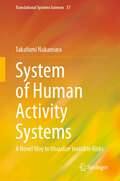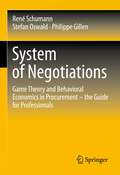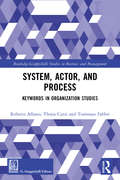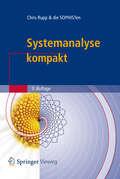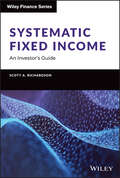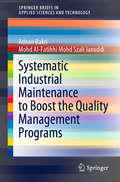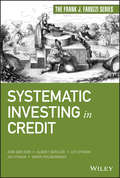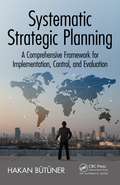- Table View
- List View
System Administration Ethics: Ten Commandments for Security and Compliance in a Modern Cyber World
by Igor Ljubuncic Tom LittererSuccessfully navigate through the ever-changing world of technology and ethics and reconcile system administration principles for separation of duty, account segmentation, administrative groups and data protection. As security breaches become more common, businesses need to protect themselves when facing ethical dilemmas in today’s digital landscape. This book serves as a equitable guideline in helping system administrators, engineers – as well as their managers – on coping with the ethical challenges of technology and security in the modern data center by providing real-life stories, scenarios, and use cases from companies both large and small. You'll examine the problems and challenges that people working with customer data, security and system administration may face in the cyber world and review the boundaries and tools for remaining ethical in an environment where it is so easy to step over a line - intentionally or accidentally. You'll also see how to correctly deal with multiple ethical situations, problems that arise, and their potential consequences, with examples from both classic and DevOps-based environments.Using the appropriate rules of engagement, best policies and practices, and proactive “building/strengthening” behaviors, System Administration Ethics provides the necessary tools to securely run an ethically correct environment. What You'll LearnThe concepts of Least Privilege and Need to KnowRequest change approval and conduct change communicationFollow "Break Glass" emergency proceduresCode with data breaches, hacking and security violations, and proactively embrace and design for failures Build and gain trust with employees and build the right ethical cultureReview what managers can do to improve ethics and protect their employeesWho This Book Is ForThis book’s primary audience includes system administrators and information security specialists engaged with the creation, process and administration of security policies and systems. A secondary audience includes company leaders seeking to improve the security, privacy, and behavioral practices.
System Analysis and Design, an Object-Oriented Approach with UML
by Alan Dennis Barbara Haley Wixom David Paul TegardenSystems Analysis and Design: An Object-Oriented Approach with UML, Sixth Edition helps students develop the core skills required to plan, design, analyze, and implement information systems. Offering a practical hands-on approach to the subject, this textbook is designed to keep students focused on doing SAD, rather than simply reading about it. Each chapter describes a specific part of the SAD process, providing clear instructions, a detailed example, and practice exercises. Students are guided through the topics in the same order as professional analysts working on a typical real-world project. <p><p> Now in its sixth edition, this edition has been carefully updated to reflect current methods and practices in SAD and prepare students for their future roles as systems analysts. Every essential area of systems analysis and design is clearly and thoroughly covered, from project management, to analysis and design modeling, to construction, installation, and operations. The textbook includes access to a range of teaching and learning resources, and a running case study of a fictitious healthcare company that shows students how SAD concepts are applied in real-life scenarios.
System Analysis and Modeling. Languages, Methods, and Tools for Systems Engineering: 10th International Conference, SAM 2018, Copenhagen, Denmark, October 15–16, 2018, Proceedings (Lecture Notes in Computer Science #11150)
by Ferhat Khendek Reinhard GotzheinThis book constitutes the refereed proceedings of the 10th International Conference on System Analysis and Modeling, SAM 2018, held in Copenhagen Denmark, in October 2018. The 12 full papers and 2 short papers presented were carefully reviewed and selected from 24 submissions. The papers describe innovations, trends, and experiences in modeling and analysis of complex systems using ITU-T's Specification and Description Language (SDL-2010) and Message Sequence Chart (MSC) notations, as well as related system design languages — including UML, ASN.1, TTCN, SysML and the User Requirements Notation (URN). This year’s edition of SAM will be under the theme “Languages, Methods, and Tools for Systems Engineering”, including languages and methods standardized by the ITU-T, and domain-specific languages. Also included are software engineering technologies, such as for requirements engineering, software verification and validation, and automated code generation.
System Dependability and Analytics: Approaching System Dependability from Data, System and Analytics Perspectives (Springer Series in Reliability Engineering)
by Long Wang Karthik Pattabiraman Catello Di Martino Arjun Athreya Saurabh BagchiThis book comprises chapters authored by experts who are professors and researchers in internationally recognized universities and research institutions. The book presents the results of research and descriptions of real-world systems, services, and technologies. Reading this book, researchers, professional practitioners, and graduate students will gain a clear vision on the state of the art of the research and real-world practice on system dependability and analytics. The book is published in honor of Professor Ravishankar K. Iyer, the George and Ann Fisher Distinguished Professor in the Department of Electrical and Computer Engineering at the University of Illinois at Urbana-Champaign (UIUC), Urbana, Illinois. Professor Iyer is ACM Fellow, IEEE Fellow, AAAS Fellow, and served as Interim Vice Chancellor of UIUC for research during 2008–2011. The book contains chapters written by many of his former students.
System Efficiency by Renewable Electricity: Strategies for Efficient Energy Supply until 2050
by Günther BraunerIn this book, a more detailed analysis is performed on the basis of quarter-hourly time series of the supply of wind energy and photovoltaics. The end use including electromobility is also presented with more detailed time series of the load profiles for summer and winter and thereby for weekdays and weekends in each case. The subsequent analysis clarifies whether the renewable potentials are sufficient, what the optimal generation scenarios and infrastructures of the future could look like, and what the situation is with regard to affordability and environmental compatibility.
System Error: Where Big Tech Went Wrong and How We Can Reboot
by Rob Reich Jeremy M. Weinstein Mehran Sahami"System Error is a triumph: an analysis of the critical challenges facing our digital society that is as accessible as it is sophisticated." — Anne-Marie Slaughter, CEO of New AmericaA forward-thinking manifesto from three Stanford professors—experts who have worked at ground zero of the tech revolution for decades—which reveals how big tech’s obsession with optimization and efficiency has sacrificed fundamental human values and outlines steps we can take to change course, renew our democracy, and save ourselves.In no more than the blink of an eye, a naïve optimism about technology’s liberating potential has given way to a dystopian obsession with biased algorithms, surveillance capitalism, and job-displacing robots. Yet too few of us see any alternative to accepting the onward march of technology. We have simply accepted a technological future designed for us by technologists, the venture capitalists who fund them, and the politicians who give them free rein.It doesn’t need to be this way.System Error exposes the root of our current predicament: how big tech’s relentless focus on optimization is driving a future that reinforces discrimination, erodes privacy, displaces workers, and pollutes the information we get. This optimization mindset substitutes what companies care about for the values that we as a democratic society might choose to prioritize. Well-intentioned optimizers fail to measure all that is meaningful and, when their creative disruptions achieve great scale, they impose their values upon the rest of us.Armed with an understanding of how technologists think and exercise their power, three Stanford professors—a philosopher working at the intersection of tech and ethics, a political scientist who served under Obama, and the director of the undergraduate Computer Science program at Stanford (also an early Google engineer)—reveal how we can hold that power to account.Troubled by the values that permeate the university’s student body and its culture, they worked together to chart a new path forward, creating a popular course to transform how tomorrow’s technologists approach their profession. Now, as the dominance of big tech becomes an explosive societal conundrum, they share their provocative insights and concrete solutions to help everyone understand what is happening, what is at stake, and what we can do to control technology instead of letting it control us.
System Error: Where Big Tech Went Wrong and How We Can Reboot
by Rob Reich Jeremy Weinstein Mehran SahamiRead this if you want to understand how to shape our technological future and reinvigorate democracy along the way. -- Reed Hastings, co-founder and CEO of Netflix__________A forward-thinking manifesto from three Stanford professors which reveals how big tech's obsession with optimization and efficiency has sacrificed fundamental human values and outlines steps we can take to change course, renew our democracy, and save ourselves.__________In no more than the blink of an eye, a naïve optimism about technology's liberating potential has given way to a dystopian obsession with biased algorithms, surveillance capitalism, and job-displacing robots. Yet too few of us see any alternative to accepting the onward march of technology. We have simply accepted a technological future designed for us by technologists, the venture capitalists who fund them, and the politicians who give them free rein.It doesn't need to be this way.System Error exposes the root of our current predicament: how big tech's relentless focus on optimization is driving a future that reinforces discrimination, erodes privacy, displaces workers, and pollutes the information we get.Armed with an understanding of how technologists think and exercise their power, three Stanford professors - a philosopher working at the intersection of tech and ethics, a political scientist who served under Obama, and the director of the undergraduate Computer Science program at Stanford (also an early Google engineer) - reveal how we can hold that power to account. As the dominance of big tech becomes an explosive societal conundrum, they share their provocative insights and concrete solutions to help everyone understand what is happening, what is at stake, and what we can do to control technology instead of letting it control us.
System Error: Where Big Tech Went Wrong and How We Can Reboot
by Rob Reich Jeremy Weinstein Mehran SahamiRead this if you want to understand how to shape our technological future and reinvigorate democracy along the way. -- Reed Hastings, co-founder and CEO of Netflix__________A forward-thinking manifesto from three Stanford professors which reveals how big tech's obsession with optimization and efficiency has sacrificed fundamental human values and outlines steps we can take to change course, renew our democracy, and save ourselves.__________In no more than the blink of an eye, a naïve optimism about technology's liberating potential has given way to a dystopian obsession with biased algorithms, surveillance capitalism, and job-displacing robots. Yet too few of us see any alternative to accepting the onward march of technology. We have simply accepted a technological future designed for us by technologists, the venture capitalists who fund them, and the politicians who give them free rein.It doesn't need to be this way.System Error exposes the root of our current predicament: how big tech's relentless focus on optimization is driving a future that reinforces discrimination, erodes privacy, displaces workers, and pollutes the information we get.Armed with an understanding of how technologists think and exercise their power, three Stanford professors - a philosopher working at the intersection of tech and ethics, a political scientist who served under Obama, and the director of the undergraduate Computer Science program at Stanford (also an early Google engineer) - reveal how we can hold that power to account. As the dominance of big tech becomes an explosive societal conundrum, they share their provocative insights and concrete solutions to help everyone understand what is happening, what is at stake, and what we can do to control technology instead of letting it control us.(P) 2021 HarperCollins Publishers
System Innovation for Sustainability 1: Perspectives on Radical Changes to Sustainable Consumption and Production
by Carlo Vezzoli Martin Charter Eivind Stø Arnold Tukker Maj Munch AndersenSustainable consumption and production (SCP) was adopted as a priority area during the World Summit on Sustainable Development in Johannesburg in 2002 and has since become one of the main vehicles for targeting international sustainability policy. Sustainable consumption focuses on formulating equitable strategies that foster the highest quality of life, the efficient use of natural resources, and the effective satisfaction of human needs while simultaneously promoting equitable social development, economic competitiveness, and technological innovation. But this is a complex topic and, as the challenges of sustainability grow larger, there is a need to re-imagine how SCP policies can be formulated, governed and implemented. The EU-funded project "Sustainable Consumption Research Exchanges" (SCORE!) consists of around 200 experts in the field of sustainable innovation and sustainable consumption. The SCORE! philosophy is that innovation in SCP policy can be achieved only if experts that understand business development, (sustainable) solution design, consumer behaviour and system innovation policy work together in shaping it. Sustainable technology design can be effective only if business can profitably make the products and consumers are attracted to them. To understand how this might effectively happen, the expertise of systems thinkers must be added to the mix. System Innovation for Sustainability 1 is the first result of a unique positive confrontation between experts from all four communities. It examines what SCP is and what it could be, provides a state-of-the-art review on the governance of change in SCP policy and looks at the strengths and weaknesses of current approaches. The SCORE! experts are working with actors in industry, consumer groups and eco-labelling organisations in the key consumption areas of mobility, food and agriculture, and energy use and housing – responsible for 70% of the life-cycle environmental impacts of Western societies – with the aim of stimulating, fostering or forcing change to SCP theory in practice. The System Innovation for Sustainability series will continue with three further volumes of comprehensive case studies in each of these three critical consumption areas. Each chapter of this book examines problems and suggests solutions from a business, design, consumer and system innovation perspective. It primarily examines the differing solutions necessary in the consumer economies of the West, but also comments on the differing needs in rapidly emerging economies such as China, as well as base-of-the-pyramid economies. The System Innovation for Sustainability series is the fruit of the only major international research network on SCP and will set the standard in this field for some years to come. It will be required reading for all involved in the policy debate on sustainable production and consumption from government, business, academia and NGOs for designers, scientists, businesses and system innovators.
System Innovation for Sustainability 2: Case Studies in Sustainable Consumption and Production - Mobility
by Theo Geerken Mads BorupThe EU-funded project "Sustainable Consumption Research Exchanges" (SCORE!) consists of around 200 experts in the field of sustainable innovation and sustainable consumption. The SCORE! philosophy is that innovation in SCP (sustainable consumption and production) policy can be achieved only if experts that understand business development, (sustainable) solution design, consumer behaviour and system innovation policy work together in shaping it. Sustainable technology design can be effective only if business can make the products profitably and consumers are attracted to them. To understand how this might effectively happen, the expertise of systems thinkers must be added to the mix. The publication in 2008 of System Innovation for Sustainability 1 was the first result of a unique positive confrontation between experts from all four communities. It examined what SCP is and what it could be, provided a state-of-the-art review on the governance of change in SCP policy and looked at the strengths and weaknesses of current approaches. System Innovation for Sustainability 2 is the first of three books of case studies covering, respectively, the three key consumption areas of: mobility; food and agriculture; and energy use and housing. These three areas are responsible for 70% of the life-cycle environmental impacts of Western societies. These case studies aim to stimulate, foster or force change to SCP theory in practice. System Innovation for Sustainability 2 focuses on change towards sustainable personal mobility based on implemented cases analysed from a system perspective. It examines what changes can be made to help us reduce our need for mobility, or start to make use of more sustainable mobility systems. This is clearly a critical and highly problematic area, as increasing living standards of a growing global population have resulted in rapid rises in both car and air travel along with the associated pollution. Uniquely, this book approaches the problems and solutions from a systems perspective, explaining the meta-trends, specific issues for the mobility sector, socioeconomic trends, political considerations, socio-cultural developments and environmental issues. As well as the mobility system itself, other societal systems that impact the need for mobility, such as labour and taxation, are addressed in order to provide sustainable solutions to our current "lock-in" problems. Three major problem areas are considered (the "three Cs"): carbon emissions (and the growing contribution of mobility to the climate change crisis), congestion, and casualties. And each strategy proposed addresses one or more of these problem areas. Among the cases discussed are: Norway's carbon compensation scheme for air travel; Madrid's high-occupancy vehicle lanes; London's congestion charge scheme; market-based instruments such as eco-labelling for cars; and taxation. The book identifies opportunities for actors such as governments, manufacturers and consumers to intervene in the complex system to promote sustainable mobility. It concludes with a reflection on problems, trends and action needed. The System Innovation for Sustainability series is the fruit of the first major international research network on SCP and will set the standard in this field for some years to come. It will be required reading for all involved in the policy debate on sustainable production and consumption from government, business, academia and NGOs for designers, scientists, businesses and system innovators.
System Innovation for Sustainability 3: Case Studies in Sustainable Consumption and Production — Food and Agriculture
by Ursula Tischner Eivind Stø Unni Kjærnes Arnold TukkerThe EU-funded project "Sustainable Consumption Research Exchanges" (SCORE!) consists of around 200 experts in the field of sustainable innovation and sustainable consumption. The SCORE! philosophy is that innovation in SCP policy can be achieved only if experts that understand business development, (sustainable) solution design, consumer behaviour and system innovation policy work together in shaping it. Sustainable technology design can be effective only if business can profitably make the products and consumers are attracted to them. To understand how this might effectively happen, the expertise of systems thinkers must be added to the mix. The publication in 2008 of System Innovation for Sustainability 1 was the first result of a unique positive confrontation between experts from all four communities. It examined what SCP is and what it could be, provided a state-of-the-art review on the governance of change in SCP policy and looked at the strengths and weaknesses of current approaches. System Innovation for Sustainability 3 is the second of three books of case studies covering respectively the three key consumption areas of mobility, food and agriculture, and energy use and housing – responsible for 70% of the life-cycle environmental impacts of Western societies – with the aim of stimulating, fostering or forcing change to SCP theory in practice. The availability of healthy food for all is a basic human need. Yet, primarily due to higher food prices, the overall number of undernourished people in the world increased from 923 million in 2007 to 963 million in 2008 – the vast majority of whom live in developing countries. Experts estimate that close to half of the human impact on the environment is directly or indirectly related to food production and consumption. Food production, distribution, consumption and disposal are important in terms of land and resource use, pollution and emissions, biodiversity and landscape design. Also of key importance are health issues and issues surrounding the satisfaction of citizens' basic needs: more than 200 million adults in the European Union are overweight or even obese due to unhealthy diets and too little exercise. Sustainability issues are now clearly on the agenda for food producers and market actors, politicians and regulators, as well as being increasingly important in the decisions consumers make about food. A large number and variety of efforts to stimulate sustainability have been instigated and numerous studies, research programmes and publications have addressed such issues. Agri-food issues have also been prominent in the evolving definition of what sustainability means. This book focuses largely on providing answers to the question of how food production and consumption systems can stay within the limits of the carrying capacity of our natural environment. But it also considers the challenges of food security and nutrition in the context of sustainability and a growing world population. The book first analyses the state of the art in sustainable agriculture and food production in Europe. Eleven case studies follow, examining issues such as food policy, greening mainstream agricultural systems, organic farming, farmers' markets, sustainable food networks, eco-labelling, consumer behaviour, slow food and fair trade. Finally, a concluding chapter summarises what has been learned by the 60-plus experts active in the SCORE! food project. In brief: bottom-up and top-down processes have to be linked, industrialised nations must reduce their meat consumption, and agriculture should become a multifunctional sustainable system not only producing food but also delivering other services such as energy and material production, CO2 storage and recreation – which would have the added benefit of improving farmers' socioeconomic situations. The System Innovation for Sustainability series is the fruit of the first major international research network on SCP and will set the standard in this field for some years to come. It will be required reading
System Innovation for Sustainability 4: Case Studies in Sustainable Consumption and Production — Energy Use and the Built Environment
by Saadi LahlouThe EU-funded project "Sustainable Consumption Research Exchanges" (SCORE!) consists of around 200 experts in the field of sustainable innovation and sustainable consumption. The SCORE! philosophy is that innovation in SCP policy can be achieved only if experts that understand business development, (sustainable) solution design, consumer behaviour and system innovation policy work together in shaping it. Sustainable technology design can be effective only if business can profitably make the products and consumers are attracted to them. To understand how this might effectively happen, the expertise of systems thinkers must be added to the mix. The publication in 2008 of System Innovation for Sustainability 1 was the first result of a unique positive confrontation between experts from all four communities. It examined what SCP is and what it could be, provided a state-of-the-art review on the governance of change in SCP policy and looked at the strengths and weaknesses of current approaches. System Innovation for Sustainability 4 is the third of three books of case studies covering respectively the three key consumption areas of mobility, food and agriculture, and energy use and the built environment – responsible for 70% of the life-cycle environmental impacts of Western societies – with the aim of stimulating, fostering or forcing change to SCP theory in practice. Energy consumption is obviously a key issue for sustainability, primarily because it depletes non-renewable fossil fuels, produces CO2 and other pollution. As climate change is becoming a key political issue, and as oil prices rise, society has become acutely aware of this issue. Energy is a special case because it is a key input to almost all other consumption and production processes. Housing is, with transport and food, a major consumer of energy, accounting for about one quarter of the environmental impact from the general consumption of products in the European Union, on a par with food and transport. Energy use in houses and buildings is also set to rise as populations – and the buildings they need –continue to increase. In France, for example, energy consumption in houses and offices accounts for 43% of the total national energy consumption, and one-quarter of national greenhouse gas emissions. The UK's 21 million homes consume around 50 million tonnes of oil equivalent (responsible for 27% of UK CO2 emissions); this energy use has increased steadily by about 1.3% per year since 1990. Germany's buildings contribute one-fifth of the country's CO2 emissions. Beyond this, buildings are the environment where we spend most of our lives; they deeply influence many other consumption patterns, and are an important factor for life and comfort. The societal function and nature of buildings as they are currently constructed presents some key difficulties in moving towards sustainable consumption and production. Buildings have a long lifetime; and therefore they are a major target for any structural changes in consumption patterns. Conversely, long lifetimes come with associated strong inertia; therefore the stock of existing buildings is often an obstacle to policies aimed at behavioural change. This book examines, through a case study approach, opportunities to influence energy consumption in housing and buildings and thereby provide options for implementation at a macro, meso and micro level. A growing body of evidence shows that cases demonstrating action towards SCP in energy use in housing can inspire innovation through a range of actors. The cases include examples of steps towards the sustainable use of energy in houses and buildings, from "local experiments", to "innovative communities", to wider regime or non-local scale change in Europe and North America. The System Innovation for Sustainability series is the fruit of the first major international research network on SCP and will set the standard in this field for some years to come. It will be required reading for all involved in the policy debate on sustainable product
System Leadership for Sustainability (Routledge Frontiers in Sustainable Business Practice)
by Christopher G. BeehnerThis book is the first to explore the application of system leadership to promote sustainable solutions for contemporary and future environmental and social problems. The combination of synthesized research summaries and case studies of individuals and organizations contribute considerably to the field by expanding system leadership concepts from theory to practical application. System leadership has been identified as a method by which complex societal problems can be addressed, but it has as yet not been applied to sustainability. The first chapters introduce the background and fundamentals of system leadership and its relevance to sustainability. The chapters that propose methods of developing system leadership, examples of system leaders, and practical application of system leadership in industry, academic, government, nonprofit, and NGO settings. Each chapter includes a chapter case, interview, and/or reflection questions in order to stimulate critical thinking and provide instructional tools for academic use and practical application. The book is particularly relevant to researchers and students internationally in the fields of social development and sustainability. It is also relevant to public, private, and nonprofit/NGO management practitioners who are curious about the leadership styles and skills necessary to develop a sustainable future.
System Lifecycle Management: Engineering Digitalization (Engineering 4.0)
by Martin EignerYears of experience in the area of Product Lifecycle Management (PLM) in industry, research and education form the basis for this overview. The author covers the development from PDM via PLM to SysLM (System Lifecycle Management) in the form commonly used today, which are necessary prerequisites for the sustainable development and implementation of IoT/IoS, Industry 4.0 and Engineering 4.0 concepts. The building blocks and properties of future-proof systems for the successful implementation of the concepts of Engineering 4.0 are thereby dedicated to holistic considerations, which also inform in detail. SysLM functions and processes in mechatronic development and design as well as across the entire product lifecycle - from requirements management to the Digital Twin - are covered as examples. SysLM trends such as low code development, cloud, disruptive business models, and bimodality provide an outlook on future developments. The author dedicates the treatment of the agile SysLM introduction to the implementation in the enterprise. The basics are deepened with examples of a concrete SysLM system.
System Management: Planning, Enterprise Identity, and Deployment, Second Edition (Systems Engineering)
by Jeffrey O. GradyThe second edition of a bestseller, System Management: Planning, Enterprise Identity, and Deployment demonstrates how to make systems development work for any organization. Updated with new chapters, examples, and figures, it discusses the optimum marriage between specific program planning and a company's generic identity. The author focuses on the
System Performance and Management Analytics (Asset Analytics)
by Ajit Kumar Verma P. K. Kapur Yury Klochkov Gurinder SinghThis book shares key insights into system performance and management analytics, demonstrating how the field of analytics is currently changing and how it is used to monitor companies’ efforts to drive performance.Managing business performance facilitates the effective accomplishment of strategic and operational goals, and there is a clear and direct correlation between using performance management applications and improved business and organizational results. As such, performance and management analytics can yield a range of direct and indirect benefits, boost operational efficiency and unlock employees’ latent potential, while at the same time aligning services with overarching goals.The book addresses a range of topics, including software reliability assessment, testing, quality management, system-performance management, analysis using soft-computing techniques, and management analytics. It presents a balanced, holistic approach to viewing the world from both a technical and managerial perspective by considering performance and management analytics. Accordingly, it offers a comprehensive guide to one of the most pressing issues in today’s technology-dominated world, namely, that most companies and organizations find themselves awash in a sea of data, but lack the human capital, appropriate tools and knowledge to use it to help them create a competitive edge.
System Synthesis: Product and Process Design
by Jeffrey O. GradyUnlike most engineers, system engineers focus on the knowledge base needed to develop good systems in a cross-functional fashion rather than deeply on isolated topics. They are often said to be a mile wide and an inch deep in what they do know. System Synthesis: Product and Process Design provides insight into complex problems, focusing on the boun
System of Human Activity Systems: A Novel Way to Visualize Invisible Risks (Translational Systems Sciences #37)
by Takafumi NakamuraThis book has unique features that set it apart from conventional books on the prevention of system failures in that it provides a method that views human activities from a meta-methodological perspective based upon an inter-disciplinary understanding of human activities. With these characteristics, the book also proposes a common methodological basis to apply to various problems surrounding society today such as an aging social infrastructure; the safety of food, medicine, and public transportation; and the creation of sustainable electricity and cybersecurity. Furthermore, since the failure of human activities is expressed in a three-dimensional space and the topological metrics are implemented, the failure trajectories can be quantitatively monitored in time series to take effective preventive measures. Considering the implementation of the topological metrics, the causes of each failure are classified into two dimensions of the degree of coupling between system elements and the interaction between the target system and the external environment. Owing to the nature of the introduction of topological metrics, all individual and diverse systems can share general topological metrics. Consequently, understanding various failures over cross-industries is possible with the use of common meta-systemic language and mutual learning between different industries, and the solution of social problems can be effectively achieved. A system of system failures (SOSF) proposed and confirmed the effectiveness of this meta-methodology for information and communication technologies (ICT) systems and the SOSF is extended to human activity systems (SOHAS: system of human activity systems) as a whole. Therefore, the SOHAS becomes an academic foundation for theoretical research on meta-methodology, and it has an impact on practitioners to prevent system failures by accumulating knowledge of failures and learning from other industries.
System of Negotiations: Game Theory and Behavioral Economics in Procurement – the Guide for Professionals
by René Schumann Stefan Oswald Philippe GillenThis book presents criteria and recommendations for successful negotiations. The System of Negotiations, which was developed on a scientific basis for this purpose, clearly illustrates the most important steps, tools and applications. By using game theory and behavioral economics, the success of negotiations in purchasing can be systematically maximized. At the same time, transparency and fairness offer a high level of acceptance among negotiating partners. To this end, numerous practical examples are used to show how contracts can be awarded in the event of competition between suppliers, and how various auction formats and differentiated communication can be used to achieve optimal savings potential. Also for situations where the supplier is a monopolist, ways are described to avoid being at the mercy of pricing power.
System, Actor, and Process: Keywords in Organization Studies (Routledge-Giappichelli Studies in Business and Management)
by Ylenia Curzi Tommaso Fabbri Roberto AlbanoSystem, Actor and Process: Keywords in Organization Studies is intended as an epistemological ‘compass’ to navigate through the multifaceted key concepts typically used in organizational practice and research. The book illustrates thirty-four keywords using a tripartite structure: each keyword is briefly discussed from three points of view, namely the system-centered, actor-centered and process-centered conception of organization, which reflects the options emerging from contemporary epistemological debate in organizational studies and, more generally, in social sciences, namely objectivism, subjectivism, and the Weberian "third way". Primarily addressed to researchers and academics in organization studies, this book is also a useful resource for undergraduate or postgraduate students, for whom it may represent a thorough introduction to organizational concepts. It will also be a valuable tool for managers to apply in their everyday practice.
Systemanalyse kompakt
by Chris Rupp Sophist GmbhSystemanalyse kompakt zeigt Ihnen die Schwerpunkte der Anforderungsanalyse im Rahmen der Software- und Systemanalyse auf. Die Anforderungsanalyse bildet das Fundament eines jeden Systementwicklungsprojektes und entscheidet daher maßgeblich über Erfolg oder Misserfolg Ihres Projektes. Gerade in der Analysephase eröffnet sich Ihnen das Potenzial zur effizienten und zielorientierten Beeinflussung der Systementwicklung: Erstellen Sie eine vollständige und eindeutige Anforderungsdefinition, bei der Aufwand und Ergebnis in optimalem Verhältnis zueinander stehen. Dabei hilft Ihnen Systemanalyse kompakt. Das Buch bringt die Haupttätigkeiten der Systemanalyse auf den Punkt. Dabei vermittelt es mit den vom International Requirements Engineering Board festgelegten Begriffen, Definitionen und Zusammenhängen neben grundlegenden organisatorischen Rahmenbedingungen zahlreiche pragmatische Ansätze, wie Sie das grundlegend notwendige Wissen - umfassend ermitteln, - verständlich dokumentieren, - effektiv verwalten - und angemessen prüfen. Lösungsvorschläge zu konkreten Problemen der Systementwicklung und praxiserprobte Tipps unterstützen Sie bei Ihrer täglichen Arbeit. So können Sie dafür sorgen, dass die Anforderungen an ein System von allen Projektbeteiligten verstanden und verwirklicht werden können.
Systematic Fixed Income: An Investor's Guide (Wiley Finance)
by Scott A. RichardsonUnderstand the role and potential of fixed income as an asset class Systematic Fixed Income: An Investor’s Guide offers readers a powerful, practical, and robust framework for investors and asset managers to preserve the diversifying properties of a fixed income allocation, and add to that unique sources of excess returns via systematic security selection. In other words, this framework allows for efficient capture of fixed income beta and fixed income alpha. Celebrated finance professional Dr. Scott Richardson presents concrete strategies for identifying the relevant sources of risk and return in public fixed income markets and explains the tactical and strategic roles played by fixed income in typical portfolios. In the book, readers will explore: The implementation challenges associated with a systematic fixed income portfolio, including liquidity and risk The systematic return sources for rate and credit sensitive fixed income assets in both developed and emerging marketsAn essential read for asset managers and institutional investors with a professional interest in fixed income markets, Systematic Fixed Income: An Investor’s Guide deserves a place in the libraries of advanced degree students of finance, business, and investment, as well as other investment professionals seeking to refine their understanding of the full potential of this foundational asset class.
Systematic Industrial Maintenance to Boost the Quality Management Programs (SpringerBriefs in Applied Sciences and Technology)
by Adnan Bakri Mohd Al-Fatihhi Mohd Szali JanuddiThis book discusses the main quality management (QM) programs and their possible integration into systematic industrial maintenance (SIM). Unlike traditional engineering maintenance books, it not only explains the theory but also provides practical examples of the integration of QM and SIM programs. It also includes reference sources, making it useful for readers wanting to explore specific areas in more depth.Chapter 1 introduces various aspects of the main quality management (QM) programs, including total quality management (TQM), just-in-time (JIT) and lean manufacturing (Lean). Subsequently, it examines the relation of quality and maintenance. Chapter 2 reviews the concepts of systematic industrial maintenance (SIM) and the application of quality control (QC) tools. Chapter 3 offers an overview, historical perspective and trends in industrial maintenance techniques. Chapters 4, 5, 6, 7, 8 and 9 focus on topics related to schedule-based maintenance, condition-based maintenance, reliability-based maintenance, computerized-based maintenance, risk-based maintenance and total productive maintenance. Covering the theory of each of these types of SIM, the chapters also explain their real-world application in QM and highlight their merits and weaknesses in the context of supporting QM.
Systematic Investing in Credit (Frank J. Fabozzi Series)
by Arik Ben Dor Lev Dynkin Jay Hyman Albert Desclee Simon PolbennikovPraise for SYSTEMATIC INVESTING in CREDIT "Lev and QPS continue to shed light on the most important questions facing credit investors. This book focuses on their latest cutting-edge research into the appropriate role of credit as an asset class, the dynamics of credit benchmarks, and potential ways to benefit from equity information to construct effective credit portfolios. It is must-read material for all serious credit investors."—Richard Donick, President and Chief Risk Officer, DCI, LLC, USA "Lev Dynkin and his team continue to spoil us; this book is yet another example of intuitive, insightful, and pertinent research, which builds on the team's previous research. As such, the relationship with this team is one of the best lifetime learning experiences I have had."—Eduard van Gelderen, Chief Investment Officer, Public Sector Pension Investment Board, Canada "The rise of a systematic approach in credit is a logical extension of the market's evolution and long overdue. Barclays QPS team does a great job of presenting its latest research in a practical manner."—David Horowitz, Chief Executive Officer and Chief Investment Officer, Agilon Capital, USA "Systematization reduces human biases and wasteful reinventing of past solutions. It improves the chances of investing success. This book, by a team of experts, shows you the way. You will gain insights into the advanced methodologies of combining fundamental and market data. I recommend this book for all credit investors."—Lim Chow Kiat, Chief Executive Officer, GIC Asset Management, Singapore "For nearly two decades, QPS conducted extensive and sound research to help investors meet industry challenges. The proprietary research in this volume gives a global overview of cutting-edge developments in alpha generation for credit investors, from signal extraction and ESG considerations to portfolio implementation. The book blazes a trail for enhanced risk adjusted returns by exploring the cross-asset relation between stocks and bonds and adding relevant information for credit portfolio construction. Our core belief at Ostrum AM, is that a robust quantamental approach, yields superior investment outcomes. Indeed, this book is a valuable read for the savvy investor."—Ibrahima Kobar, CFA, Global Chief Investment Officer, Ostrum AM, France "This book offers a highly engaging account of the current work by the Barclays QPS Group. It is a fascinating mix of original ideas, rigorous analytical techniques, and fundamental insights informed by a long history of frontline work in this area. This is a must-read from the long-time leaders in the field."—Professor Leonid Kogan, Nippon Telephone and Telegraph Professor of Management and Finance, MIT "This book provides corporate bond portfolio managers with an abundance of relevant, comprehensive, data-driven research for the implementation of superior investment performance strategies."—Professor Stanley J. Kon, Editor, Journal of Fixed income "This book is a treasure trove for both pension investors and trustees seeking to improve performance through credit. It provides a wealth of empirical evidence to guide long-term allocation to credit, optimize portfolio construction and harvest returns from systematic credit factors. By extending their research to ESG ratings, the authors also provide timely insights in the expanding field of sustainable finance."—Eloy Lindeijer, former Chief of Investment Management, PGGM, Netherlands "Over more than a decade, Lev Dynkin and his QPS team has provided me and APG with numerous innovative insights in credit markets. Their work gave us valuable quantitative substantiation of some of our investment beliefs. This book covers new and under-researched areas of our market
Systematic Strategic Planning: A Comprehensive Framework for Implementation, Control, and Evaluation
by Hakan ButunerThis book provides a complete set of practical strategic planning techniques and tools. Readers are guided in identifying how and in what circumstances they might use particular tools, and in targeting them directly at achieving effective results. Systematic Strategic Planning consists of a framework of phases through which each project passes, a pattern of procedures for straight-forward planning and the fundamentals involved in any strategic planning project. The book is designed to be simple to understand and easy to use.
